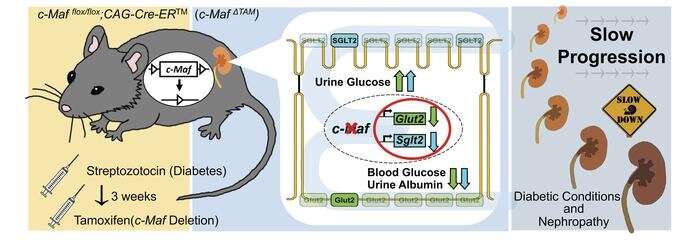This article has been reviewed according to Science X's editorial process and policies. Editors have highlighted the following attributes while ensuring the content's credibility:
fact-checked
peer-reviewed publication
trusted source
proofread
Regulatory protein offers a protective effect in the diabetic kidney

The kidneys perform a critical role in the body by removing waste and excess fluid in the form of urine. In a condition known as diabetic nephropathy, complications from diabetes disrupt the ability of the kidneys to function properly. Now, researchers in Japan have shed new light on a potential target for the development of therapies for the treatment of diabetic nephropathy.
In a new study published in JCI Insight, researchers led by University of Tsukuba employed an inducible mouse model to investigate the role of transcription factor c-Maf in the adult mouse kidney under normal and diabetic conditions.
c-Maf is a transcription factor (a type of protein that regulates gene activity) that plays a role in embryonic kidney development. However, determining the function of c-Maf in the adult kidney has been challenging, as c-Maf deletion results in embryos that are unable to survive. To address this challenge, the research team from the University of Tsukuba developed a mouse model in which c-Maf can be inactivated via application of a drug called tamoxifen, which is commonly used to treat breast cancer. The research team called this model c-Maf ΔTAM, and set out to investigate the role of c-Maf in the adult kidney using these c-Maf ΔTAM mice .
"Our initial analyses revealed that compared with control mice, c-Maf ΔTAM mice exhibited higher glucose levels in urine, increased water intake and urine output, and higher urinary albumin levels following treatment with tamoxifen," says senior author of the study, Professor Satoru Takahashi. "However, no morphological changes were observed in the kidneys of c-Maf ΔTAM mice."

The researchers identified genes that were differentially expressed in c-Maf ΔTAM and control mice. They found that two key transporters of blood sugar, Sglt2 and Glut2, showed lower expression in c-Maf ΔTAM mice. Further investigation revealed that c-Maf appeared to directly control the expression of these two sugar transporters.
The researchers then evaluated the effects of diabetic conditions in c-Maf ΔTAM mice. "Under diabetic conditions, c-Maf deletion appeared to lower blood glucose levels through the regulation of Sglt2 and Glut2 expression," says Professor Takahashi. "Furthermore, c-Maf deletion promoted recovery from hyperglycemia and suppressed diabetic nephropathy."
These findings indicate that c-Maf deletion can improve diabetic conditions and offers protective effects in the kidneys. c-Maf may be a potential target for the development of therapeutics for the treatment of diabetic nephropathy.
More information: Mitsunori Fujino et al, Transcription factor c-Maf deletion improves streptozotocin-induced diabetic nephropathy by directly regulating Sglt2 and Glut2, JCI Insight (2023). DOI: 10.1172/jci.insight.163306


















